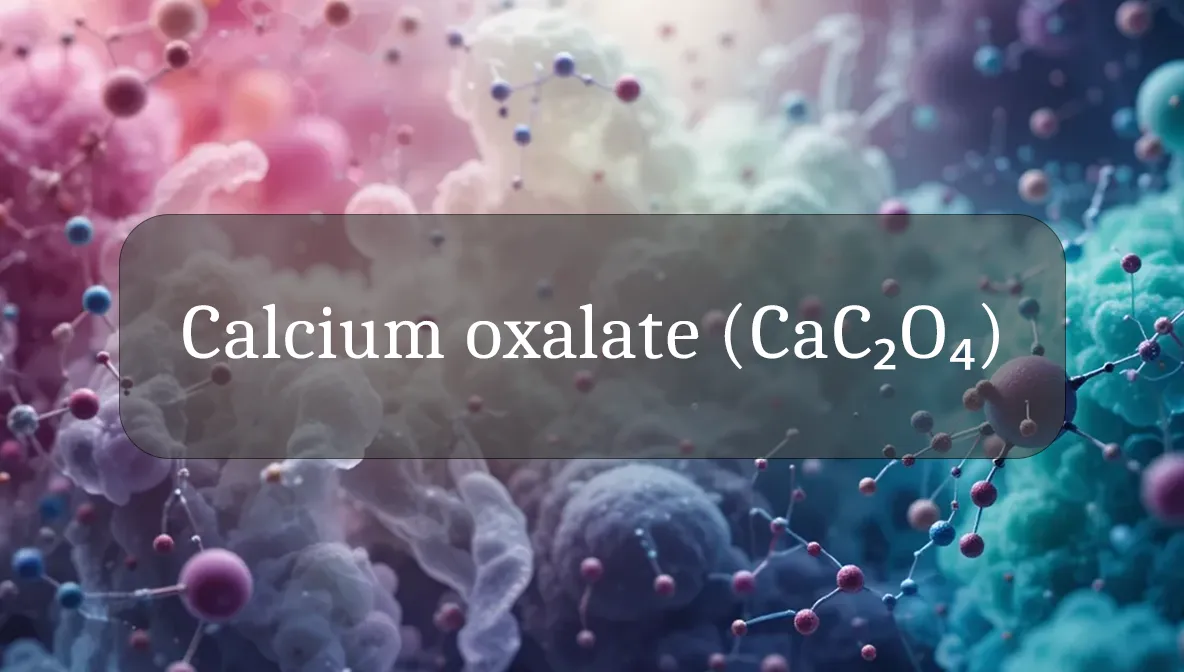Common Compound with a Key Role in Health Awareness
Calcium oxalate (CaC₂O₄) might not be a nutrient, but it’s a molecule you’ve likely heard about if you’ve ever dealt with kidney stones. Found in certain foods and formed in your body, this compound is important to understand for maintaining kidney health and overall wellness. Let’s explore what calcium oxalate is, why it matters, and how to manage it for a healthier you, all in a friendly, easy-to-understand way.
Chemical Identity and Type
Calcium oxalate (CaC₂O₄) is a molecule made of one calcium atom bonded to two carbon atoms and four oxygen atoms. It’s a neutral compound that forms insoluble crystals, meaning it doesn’t dissolve easily in water. In your body, calcium oxalate is created when calcium (from foods like dairy) combines with oxalate (from foods like spinach or your body’s metabolism). While it’s a natural byproduct, excess calcium oxalate can form crystals that lead to kidney stones, making it a molecule to watch for health balance.
Biological Role and Benefits
Calcium oxalate doesn’t have a direct beneficial role in your body like a nutrient, but its presence serves as a reminder of your body’s complex chemistry:
- Waste Excretion: Calcium oxalate is a normal byproduct of metabolism, helping your body get rid of excess calcium and oxalate through urine, keeping your system balanced.
- Plant Defense: In foods like spinach or rhubarb, calcium oxalate acts as a natural defense for plants, protecting them from pests. For humans, this means these foods are nutritious but need moderation to avoid excess oxalate.
- Bone Health (Indirectly): By binding calcium in the gut, oxalate can reduce calcium absorption, which underscores the importance of balancing calcium-rich foods to support strong bones.
Understanding calcium oxalate’s role helps you prevent issues like kidney stones while enjoying a varied diet.
Dietary or Natural Sources
Calcium oxalate isn’t consumed directly but forms from dietary and bodily sources:
- Dietary Sources:
- High-Oxalate Foods: Spinach, rhubarb, beets, sweet potatoes, nuts (like almonds), tea, and chocolate contain oxalates that can combine with calcium.
- Calcium-Rich Foods: Dairy (milk, cheese), fortified foods, or supplements provide calcium that can bind with oxalate in the gut or kidneys.
- Body Production: Your liver produces oxalate as a byproduct of metabolizing proteins, vitamin C, or other compounds, contributing to calcium oxalate formation.
- Environmental Sources: Oxalates are in soil and water, entering the food chain through plants. Calcium is naturally in water (especially “hard” water) and soil, adding to dietary intake.
- Supplements: High doses of vitamin C supplements (over 1,000 mg daily) can increase oxalate production, raising calcium oxalate levels.
A balanced diet with moderate oxalate and calcium intake helps manage calcium oxalate formation.
Signs of Imbalance or Dysfunction
Calcium oxalate imbalances are primarily linked to excess crystal formation, leading to health issues:
- Excess Calcium Oxalate (Kidney Stones):
- Symptoms: Severe pain in the back or side, blood in urine, frequent urination, nausea, or fever if infected.
- Causes: High oxalate intake (from foods like spinach), dehydration, low calcium intake (which allows more oxalate absorption), or genetic predisposition.
- Impact: Can cause painful kidney stones, block urine flow, or lead to kidney damage if untreated.
- Low Calcium Oxalate: Not typically a concern, as it’s a waste product. However, very low oxalate intake might indicate a diet lacking nutrient-rich plant foods, potentially missing other benefits like fiber.
If you experience symptoms like intense pain or blood in urine, seek medical attention promptly to check for kidney stones or other issues.
Supporting Optimal Levels or Function
Managing calcium oxalate is about preventing excess crystal formation while enjoying a healthy diet:
- Balance Oxalate and Calcium Intake: Pair high-oxalate foods (like spinach) with calcium-rich foods (like yogurt) during meals. Calcium binds oxalate in the gut, reducing absorption and kidney stone risk.
- Stay Hydrated: Drink 10–12 cups of water daily to dilute urine and prevent calcium oxalate crystals from forming. Add lemon juice, which contains citrate to break down stones.
- Moderate High-Oxalate Foods: Enjoy spinach, nuts, or tea in moderation (e.g., 1–2 servings daily). Cooking or boiling high-oxalate veggies can reduce oxalate content.
- Limit Vitamin C Supplements: Keep vitamin C intake below 1,000 mg daily from supplements to avoid excess oxalate production. Get vitamin C from fruits like oranges instead.
- Watch Sodium and Sugar: High sodium (from processed foods) or sugar can increase calcium in urine, raising stone risk. Aim for less than 2,300 mg sodium daily.
Routine urine or blood tests can monitor kidney health, especially if you have a history of stones.
Safety, Interactions, and Precautions
Calcium oxalate is safe as a natural byproduct in small amounts, but excess requires caution:
- Safety: Normal dietary oxalate and calcium intake pose no risk for most. High oxalate levels from diet or metabolism can lead to kidney stones, especially in predisposed individuals.
- Interactions: Calcium supplements can reduce oxalate absorption if taken with meals but may increase stone risk if taken without food. Certain medications (like antibiotics or diuretics) may affect oxalate metabolism.
- Precautions:
- People with a history of kidney stones, kidney disease, or hyperoxaluria (excess oxalate production) should work with a doctor to tailor oxalate and calcium intake.
- Avoid extreme low-calcium diets, as they increase oxalate absorption, raising stone risk.
- Environmental Concerns: High oxalate in water or soil is unlikely to impact health but may affect plant-based food content.
Fun Fact
Did you know calcium oxalate gives some plants a crunchy bite? In veggies like rhubarb or spinach, tiny calcium oxalate crystals create a gritty texture, acting as nature’s defense while adding a unique mouthfeel to your salad!
Citations
- National Institutes of Health (NIH). (2023). Kidney Stones: Causes and Prevention.
- Mayo Clinic. (2024). Kidney Stones: Symptoms and Causes.
- Cleveland Clinic. (2023). Oxalate and Kidney Health.
- World Health Organization (WHO). (2022). Nutrition and Kidney Disease.
- USDA National Nutrient Database. (2023). Oxalate Content in Foods.

